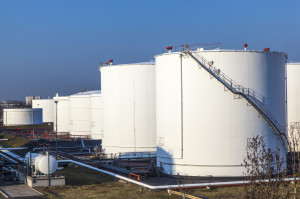 WTI and Brent futures were slightly lower during midday trade in Europe today, after gaining on the US oil report on Wednesday. Meanwhile, natural gas futures climbed, despite the US posting another massive weekly build for stocks.
WTI and Brent futures were slightly lower during midday trade in Europe today, after gaining on the US oil report on Wednesday. Meanwhile, natural gas futures climbed, despite the US posting another massive weekly build for stocks.
WTI for September delivery stood at $102.94 per barrel at 14:23 GMT in New York today, down 0.17%. Prices ranged from $103.31 to $102.67 per barrel. The contract gained 0.71% yesterday, and was up about 1.1% for the week.
Meanwhile, September Brent on the ICE in London traded at $107.74 per barrel, down 0.27%. Daily high and low were at $108.21 and $107.61 per barrel, respectively. Brent’s premium to WTI was $4.80, after last session’s closing margin of $4.91. The European contract added 0.65% on Wednesday, and was up some 0.8% for the week.
US oil inventories
The US Energy Information Administration (EIA) posted its weekly oil inventories report for the seven day through July 18 yesterday. The log revealed a 4 million-barrel draw for commercial crude oil inventories, while gasoline and distillates added 3.4 and 1.6 million barrels, respectively.
“The increase in gasoline and distillate inventories and the fall in demand is weighing on the entire complex,” John Kilduff, partner at Again Capital LLC, a New York-based hedge fund that focuses on energy, said for Bloomberg. “We didnt rise off the surprisingly strong weekly jobs report this morning, which shows the inherent weakness of the market.”
Meanwhile, oil at Cushing, Oklahoma, the delivery point for the NYMEX contract and the largest hub in the US, was reported at 18.8 million barrels for a 1.5 million-barrel draw.
Ukraine crisis
Two military aircraft were shot down by rebels over eastern Ukraine late on Wednesday, near the MH17 crash site. Authorities reported that the warplanes were at an altitude of some 5 kilometers when they were shot down, suggesting a Buk missile was used to bring them down.
A rebel spokesman denied that the separatists possess such weaponry, adding that the Ukrainian jets were shot down by a short-range mobile anti-aircraft weapon.
The US and UK earlier expressed unwavering confidence that it was indeed a Soviet-era Buk missile which brought down the Malaysian airliner last week. The Boeing 777 was shot down over rebel-held territory in Ukraine last Thursday, killing all 298 people on board.
Meanwhile, the EU is expected to release the expanded list of sanctioned Russian and Ukrainian individuals and companies later today. The Bloc’s members states’ foreign ministers decided to step up measures against entities thought liable for obstructing peace in Ukraine. The measures are said to target Russian high-tech, energy and defense firms, in a move similar to that of the US last week.
Just hours before MH17 was shot down the US also widened the list of sanctioned entities. The list of companies included small-arms manufacturer Kalashnikov, Gazprombank, a leading Russian bank, as well as state-owned energy giant Rosneft.
Natural gas
Front month natural gas futures, due in August, traded at $3.841 per million British thermal units (mBtu) at 14:41 GMT in New York today, up 2.10%. Prices ranged from an eight-month low of $3.744 to $3.886 per mBtu. The contract lost 0.27% on Wednesday and was down about 4.8% for the week, having lost the same amount last week as well.
The EIA posted natural gas storage data today, revealing an injection of 90 billion cubic feet (Bcf) for nat gas inventories in the week ended July 18. The build was not as big as some analysts expected, though it still was 34 Bcf larger than the 5-year average. Stocks were 20.2% below last years reading for the week.
“Because of these sustained big injections we’ve had constantly, it’s eroded some of the fear about having enough gas going into next winter,” Tom Saal, senior vice president of energy trading at FCStone Latin America LLC in Miami, said for Bloomberg before the report. “The biggest sellers have been the speculators getting out of their net-long positions.”
Natural gas-market analysts at NatGasWeather.com, who predicted a build of 90-94 Bcf, say the following few weeks will also see massively larger-than-average inputs. The analysts add, however, that prices are extremely oversold and are due for a rally at any time.
NatGasWeather.com reported on Thursday that the first in a series of cool blasts from Canada is continuing to track over the northern US, lowering temps and bringing clouds and some rain to the region. The following systems will have more of an impact on US temperatures, and will bring much more unsettled weather. The southern and western US will remain within an area of high pressure, keeping readings relatively high, apart from the extreme Southeast and Northwest, which will be briefly subject to cooler systems. Cooling demand over the next seven days will probably be low.
In the 8-14 day outlook, NatGasWeather.com projects a neutral trend for the US, with the Midwest and Northeast experiencing several degrees of cooling, with the cool blasts entering from Canada. The western and southern states will see little weather excitement, with high pressure dominating the outlook, keeping temps high.





